
Bravely Default II Review
When I played the first Bravely Default back in 2014, I didn't exactly like it - but over time I grew to respect it. It’s modern take on the job system was a solid revival of classic gameplay mechanics seen in some of the best Final Fantasy games, and the story was incredibly ambitious. If that didn’t alienate some of you enough, this might further: I then fell wildly in love with the sequel, Bravely Second. It addressed everything I didn’t like about the first game and inserted a lot of creativity to the job system. Now we’ve finally got the next entry in the series, the somewhat confusingly titled Bravely Default II.
Newcomers worried that they have to play two 3DS RPGs to understand the story of Bravely Default II can rest easy: that’s not necessary, as this sequel is set in a brand new world. There are no direct relations to the past games, and the focus is on a new conflict and cast of characters. It does quite a good job playing with fan expectations on what a Bravely game should be, but Bravely Default II strives to forge its own path.
I have a great fondness for the job system, the nostalgic feeling of exploring the world of a classic JRPG, and the brilliant music by composer Revo. I was tremendously excited, and my expectations were high. I’m happy to say that Bravely Default II more or less meets those expectations. It plays some parts of the formula safe to appease new and old fans alike, but by the time the credits rolled I found myself fascinated with some of its design. Where Bravely Default II slips up in terms of game balancing, it makes up for it with a heart that shines brighter than almost any other JRPG I’ve played in recent memory. I think I love this game, yet understanding that love has been a complicated journey.
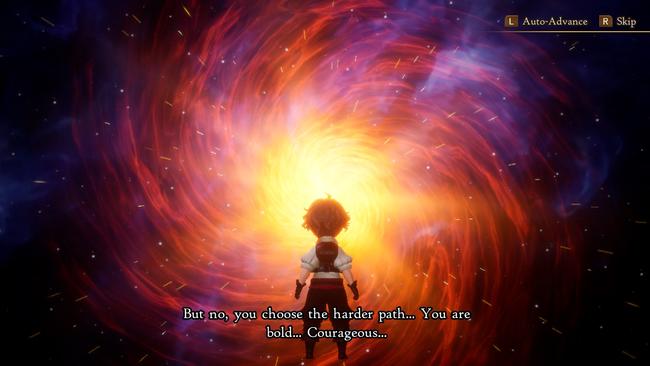
Here’s the thing. I didn't merely “play” Bravely Default II; I devoured it. To my knowledge, there is nothing left for me to do in this game. I’ve combed every inch of this world to discover every secret possible. This is strange for me, as I never find myself attempting to 100% any game. In this dedication I realize that my experience will likely differ greatly from the casual player’s. After around 75 hours of selling my soul to the game, of which 55 or so were spent ‘beating’ it, my perspective has changed more than I expected since I previewed the first 10 hours a few weeks ago. There are aspects I liked that grew to grate on me, parts I enjoyed that I love now, and negatives that turned to positives. All the good, bad, and average aspects of the game have somehow only heightened my overall enjoyment of it.
Bravely Default II’s story will be familiar, cozy even, to anyone who has played a handful of popular JRPGs released before the beginning of this millennium. Lead character Seth (whose name you can pick for yourself, making it so that no character in the game can vocally say his name) is a sailor who finds himself washed up on the shores of the continent of Excilliant. He meets Gloria, a princess of the destroyed city of Musa, and two travelers named Adelle and Elvis. The four join forces on a quest to reclaim the four elemental crystals and save the world. I enjoy the story overall and feel that despite lacking the narrative ambition of Default or Second, Bravely Default II brings enough new ideas to the table that it’s hard to not find it generally satisfying.
Player relation to the cast of playable characters isn’t just achieved through the story, but also through the Job System, with deep customization that breathes characterization into the thousands of battles you’ll fight on your journey.
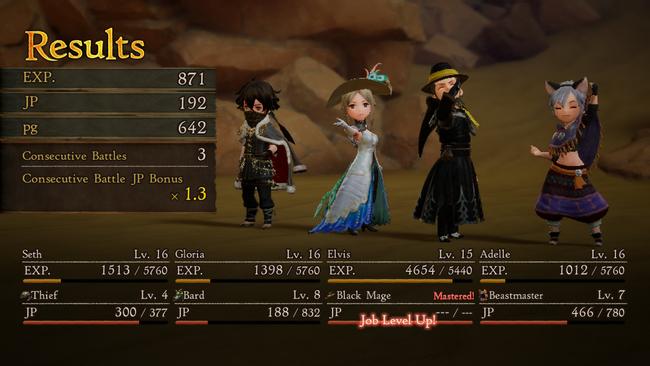
The biggest news here is that random encounters are gone. Enemies now roam the overworld and dungeons, letting the player initiate fights by running into them or hitting them with an overworld-bound melee attack to start battle with the initiative. This change is a matter of personal preference - and while I miss the freedom of turning off encounters entirely, this generally feels like a net positive. I felt in more control of my experience thanks to how you can skirt around one nasty-looking enemy but actively engage another. The overworld attack actually has other uses too, such as cutting grass back to find hidden items. The run button is also a very welcome addition.
Bravely Default II continues the series' tradition of borrowing mechanics and ideas from golden-age turn-based Japanese RPGs, especially 16-bit era Final Fantasy. The biggest twist remains the system from which the series gets its name: turns exist in the form of a fluctuating stock for each character called Brave Points. By clicking a button, characters can “Brave” and pull from this stock to use up to four turns at once. If your turn stock goes into the negative, a character won’t be able to act until their BP builds back to zero. This is Defaulting - the act of defending and skipping a turn. If a character successively defaults to build up three BP, they can unleash four turns at once and not be put into the negatives.
To stretch an analogy, managing this system is like managing money in the real world. If you want that shiny new TV, you’ve got options: do you save up for it over time, or do you borrow and get it right away? If you do choose to borrow, how vulnerable does it make you? Bravely Default is built around this concept, but with swords and magic.

Bravely veterans should know that the series tradition Brave and Default being mapped to the left and right shoulder buttons respectively has ended. By default (pun intended, sorry) players must manually select the Default Command from the battle menu, while the right shoulder button lets you Brave. If you hate this, there’s a toggle buried in the settings for “Quick Default”, which will map the function to the left shoulder button. The buttons will be reversed, but at least fans will have less to get used to.
The flow of battle has also changed. The previous system had you pick all of your moves for each character at the beginning of the turn, whereas this game calculates the character’s speed stat among a few others to decide when the character and enemies can act, and then you instruct each character one at a time. I was pretty hesitant about this at first because I found the quality of life improvements in Bravely Second to lead to brilliantly paced battles with a focus on how you can kill all the enemies in one turn to maximize efficiency in gaining EXP. While battles here feel a bit slower, this change encourages players to take their time to think every move out.
Where Bravely Default II stumbles, and hard, is in the game balance. This series has always been pretty challenging, but this title is something else. Dungeon encounters have a gradual difficulty that you can find yourself getting used to, with enemies running away from you on the overworld if they deem you too high a level. You’d think that once you reach the point where a dungeon’s standard mobs flee from you, you’d be ready for the boss - but the boss difficulty spikes are high, and brutal. They can easily wipe your entire party even if you think you should naturally be ready for it based on breezing through the preceding dungeon.
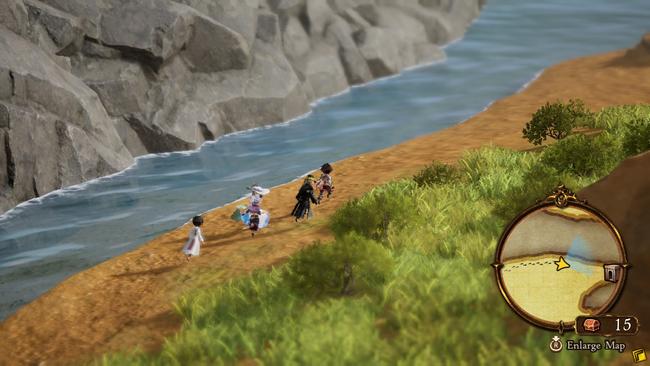
It also doesn’t help that dungeons also tend to increasingly overstay their welcome as the game goes on, and there are a lot of them. The removal of dungeon maps and a general increase in dungeon size exacerbates this and means that it’s easier to get lost and harder to find chests. Grinding is the order of the day, then - which will either be a deal breaker or no big deal, depending on what sort of RPG player you are. I got into it eventually. It’s also worth noting that even the ‘Casual’ difficulty mode can still offer a significant challenge; I checked out both, and sometimes it didn’t even feel that different to Normal mode. Regardless of difficulty, these fights require you to have a solid understanding of every single party members’ jobs and how they mesh together to succeed.
Speaking of jobs, it’s fair to say that Bravely Default’s take on the job system has always been my favorite from Square Enix. There’s a fun balance between offense and defense, and it keeps battles both engaging and rewards players for being adaptable. Combining this with the deeply customizable job system ensures that almost everyone’s party progression will be unique. Each of the four Heroes have starting stats that gravitate towards a specific playstyle to point you in the right direction, but you can build them any way you wish.
Each of the party members start with only the freelancer class. Further jobs, known as “Asterisks”, can be unlocked by defeating certain story bosses. The main exception is the Black Mage job, which Elvis joins the party with and has essentially become his main outfit in all official art. I bring this up only because I like to imagine that they drew the characters and all their different Job outfits before anything else, saw that the planets aligned when they drew him in that snazzy Black Mage coat, and just wrote his entire character around that. Don't believe me? Look at his freelancer design and compare the two.
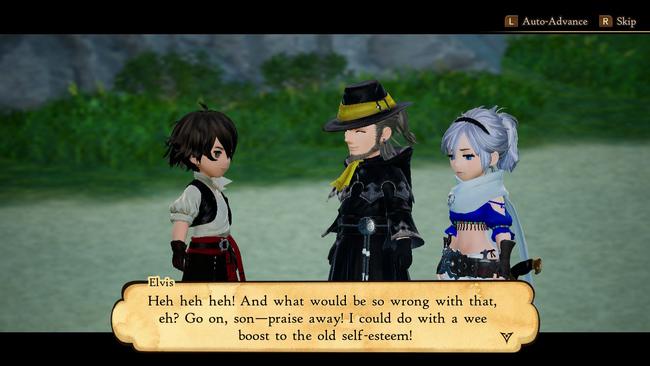
There are over 20 jobs to collect around the world of Bravely Default II, and each character can equip a Main and Side Job. Jobs are leveled up separate from normal character levels as you finish battles, offering two different kinds of progression for players to engage with throughout. The Main Job will decide what stats and equipment affinity the character will get, and Side Jobs will expand the available abilities they can use depending on how much of that job they’ve mastered. It's a good idea to juggle progressing multiple jobs as you go on, because keeping side jobs adequately leveled up is the best way for them to be useful. Another layer of depth comes from passive skills you can learn, and can be equipped in one (or two) of five slots and carried over to any other job. This is just how it was in the previous games, but I find it to be more thought out. Jobs level up faster than I remember them doing before, and that meant I felt more comfortable experimenting with new Jobs to learn passives that would benefit others.
I have some nitpicks with this system, but overall I found it just as addictive if not more so than any past version I’ve played. A minor change that I absolutely adored was Magic no longer needing to be purchased in stores. Spells are instead unlocked entirely by Job levels. I always found this to be an unnecessary second step that drained money that I often already struggled to raise. You feel like you’ve earned the new skills, not just the right to use them.
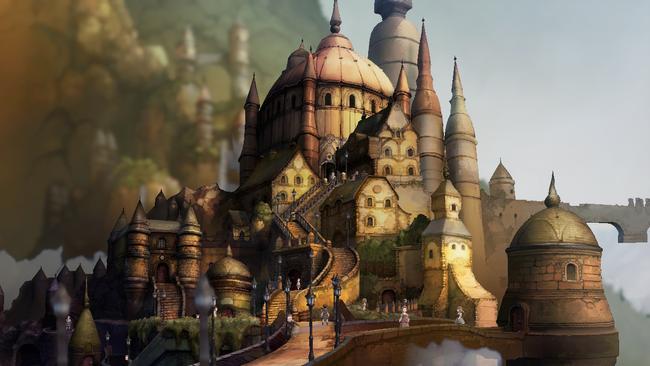
I’m still rather mixed on the weight system for equipment, but I think I’ve grown to appreciate it more. If any job could equip any piece of equipment it would likely make support and magic builds too strong. By having job-related character equipment weight limits, it helps to ensure that each job has pros and cons. The only main downside I have with the system overall is that I feel like the Job choices were played a bit safe. Love or hate Bravely Second, the Jobs in that game were incredibly creative. I don’t dislike any of them in this game, but I feel like they could have had a few more weird picks. A summoner class would have been a great addition, especially given the beautiful aesthetic the Bravely games have put into their Summons.
I nevertheless still found the battle mechanics to be fascinatingly deep and enjoyable. When you really understand how everything works and have the proper Job abilities, even the toughest battles can be a ton of fun. It’s also worth mentioning that those who enjoy breaking the difficulty in two can do just that with the right amount of time put in, and that’s just as enjoyable in its own way. With so many ways to customize your experience in battles, any fan of turn-based combat is likely to fall for the gameplay hard.
There’s a lot more you can do in the world than just battles, believe it or not. Cities serve as hubs for your adventures, and are just as gorgeous as they ever were. You feel like you’re exploring in paintings come to life, and the Switch’s bump in resolution goes a long way in adding to the immersion here. The new minigame featured here is an in-universe card game, but unfortunately I found my tiny brain incapable of truly understanding how it really worked. There are less cities overall, but all of them are much bigger to make up for this. I love this change as it gives each locale a unique visual identity and allows them to be packed with more content. Side quests are also found here, and are updated each chapter, so it's a good idea to revisit each city frequently.
Instead of using side quests sparingly to get new optional Jobs, they’re instead handled like most traditional modern RPGs. They all require you to do tasks for people in need, listening to their problems and helping them out for various rewards - a handful also unlock jobs. You’re often gathering items, killing specific monsters around the world, and going back and forth to talk to NPCs. With this format, Bravely Default II’s side quests are predictably hit or miss, though they’re at least partially saved by the numerous quests that help flesh out the game’s main and supporting cast. These are always apparent right away due to the inclusion of voice acting, and are consistently great. A lot of development of the group’s dynamics and personalities are found here, and I always love when games make you work for this kind of development. I think some of the near 100 quests could have been better, but I did them all anyway so I clearly didn’t hate them that much.

Much praise, then. But there’s a dead-eyed elephant in the room that I must address. Akihiko Yoshida’s iconic art defined the Bravely Default series, breathing life into hardware-limited visuals. Yoshida did not return for Bravely Default II, with art direction instead being handled by Hajime Onuma and Naoki Ikushima. I find this new art direction both gorgeous and distinct, which is fitting to give this game a new identity. Many people have said that the art was not accurately conveyed in 3D by developer Clay Tech Works. It certainly comes down to preference, but after playing the game for 75 hours I have to say that it grew on me a lot after around 15. With that said, anyone going into this title needs to understand that there is something of a disconnect between the doll-like character models and the beautiful background art.
Reviewer, Video Essayist, Game Designer, and all-around cool dude Tim Rogers made an excellent thread on Twitter that helped me organize my own thoughts on the game’s aesthetic. It’d be unfair of me to raise these ideas without giving him credit. Tim’s tweets are a comic call to play Bravely Default 2 undocked - and that lines up. I played my entire playthrough in handheld mode, and I think that was what helped me warm to its artistic proclivities. I still don’t think it holds up to the original 3DS titles. In high definition, these human character models have an uncanny look to them that can be unsettling or, worse, cheap-looking. But in handheld mode, I found the game reminiscent of PSP era RPGs in the best possible ways.
Playing Bravely Default II, it’s clear that it was made on a smaller budget than many Square Enix games. That’s not a bad thing though, and the game more than makes up for it with the amount of content and voiced dialogue. Perhaps I was tricked by the smaller screen and lower resolution in handheld mode, but I feel Bravely Default II has a unique charm to it that sets it apart from and resonates slightly differently than the originals. Clay Tech took a risk here, and I think doing so was the right move. It’s not for everyone, but anyone willing to look past an initially awkward aesthetic will find a lot to love. The environments, particle effects, and monsters look truly stunning. The character models aren’t the best and could have been much more expressive, but I couldn’t help but grow to love it.
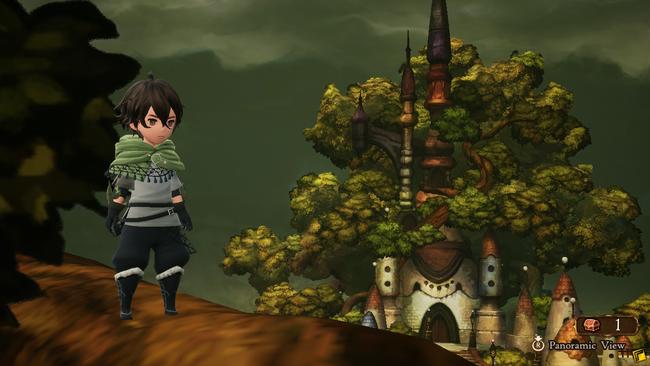
The previously-mentioned tried and true story premise is about as simple as an RPG could get, but that works in the game’s favor. The characters are a true highlight of the game, and the writers did a good job using familiar archetypes to help us warm up to the new four Heroes of Light while still giving them room to breathe. While the western versions aged up the cast of Bravely Default, it’s hard not to think of them as teenagers given their dialogue. Bravely Default II side-steps this issue all by making them adults, and it’s quite refreshing to see the team occasionally relax at the pub together. This level of maturity was rather welcome and felt in the tone of the entire story. This game’s localization is also stunning, handled by the teams who brought us the magnificent Dragon Quest XI in English. A wonderfully talented cast of European and British based actors were brought on to give it a typical medieval fantasy feel, adding to my enjoyment significantly.
Bravely Default II’s plot is not exceptional, but it is very well told for the most part. Without spoiling anything, I think it streamlines a lot of what makes Bravely so memorable while still keeping a lot of the soul. Elements of this did disappoint me, though I also admit some of the changes are smart moves that make the game more approachable. Certain elements I felt lacked sufficient payoff, but I can forgive almost all of my issues with the plot thanks to Bravely Default II’s absolutely excellent usage of its chosen themes. In almost every single main and side story arc, the writers explore stories of people dealing with the loss of loved ones. While I’m sure some will disagree, personally I feel that the game strikes a good balance between the themes being too subtle and being beaten over your head. Death affects everyone in different ways, and the examination of these different perspectives consistently lead to the most fascinating parts of the story. The tale felt strikingly human, and made it stand out compared to the past games.
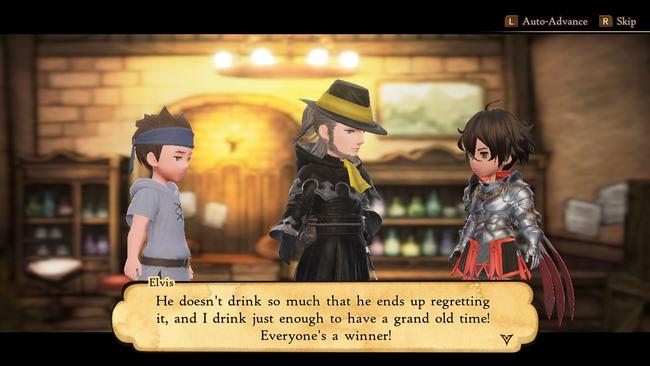
There’s one aspect of this game that is basically impossible to criticise - the music. Revo makes a triumphant return, and I honestly feel he surpassed his work from the original Bravely Default. Battle themes have a thrilling rhythm to them that always gets the blood pumping. The overworld theme has lovingly-crafted variants depending on what part of the continent you’re at, and naturally transitions between them when you walk from one to the next. City themes all manage to be unique and provide a sense of authenticity to the cultures that define them. I cannot stress this enough: I haven’t needed to own a soundtrack this badly in a very long time. Tracks manage to both implement leitmotif and relate to the themes of the game. The soundtrack was so breathtaking at points that certain songs made me tear up, a fact I’m not ashamed to admit. Revo has done a phenomenal job, and this game’s music will stick with me for a long time to come.
Playing Bravely Default II was a truly memorable experience. Games like this just aren’t made very often any more. The flaws are very visible and your mileage will vary depending on what you value in your RPGs, but there is a great game here for fans and newcomers alike as long as you’re willing to look for it. Even with the issues noted throughout this review, Bravely Default II grabbed my attention and refused to let it go for 75 hours. It truly cemented my love for the job system.
I wish it didn’t play things so safe, but in hindsight I understand the logic behind that decision. The focus was shifted to a more grounded story with a cast of loveable characters that I found to be a big improvement over Bravely Default’s cast. I was addicted to this game from start to finish, and even after completing everything it has to offer, I still haven’t had enough. I was able to look past the flaws - and if you can too, you’ll have an absolute ball.